| |
| |
| |
| |
| |
| |
ANGLO-SAXON OXFORDSHIRE
Late Anglo-Saxon Oxford (AD850-1066)
During the tenth century Oxford is first mentioned by name in several documents. In Old English the city was called Oxnaforda, literally meaning ‘the ford of the Oxen’. (Find out more about Anglo-Saxon placenames)
The earliest reference to Oxford is in the Anglo-Saxon Chronicle for the year 911-912 when Edward the Elder took possession of the town. Oxford is also listed in the Burghal Hidage, which dates to 914-919. It is listed as one of 33 fortified burhs created to defend against Viking raids.
Oxford and the Anglo-Saxon Chronicles
The Burh Defences
The best evidence for the town’s late Saxon defences comes from excavations in St Michael Street located near to the church of St Michael at the North Gate. The tower of which dates to the eleventh century and is probably the oldest surviving building in Oxford.
 |
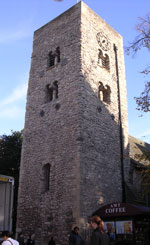 |
St Michael's Church at the Northgate |
|
Excavations in this area have produced evidence for an earth rampart faced with turf in front of which was a ditch. The rampart and town defences are thought to date from the tenth century, but there is no clear evidence for this date.
It seems the fortifications may have been extended and improved during the early eleventh century. The extent of the fortifications are also uncertain and have only been clearly identified to the north and east of the city centre. The defences appear to have been extended to the east at some point, but the evidence for this is by no means certain.
The Town Gates
Early Oxford was laid out with two principle access roads; one running north-south, probably following the route of the earlier Thames river crossing, and the second running east-west. These roads met at a central crossroads later known as Carfax.
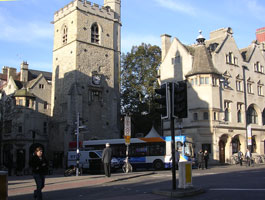 |
Carfax crossroads |
The tower of St Michael’s is located beside what would have been the north gate, although the form of the gate is unknown. The tower itself is thought to date from between 1010 and 1060 due to its architectural style.
The south gate is assumed to have stood where the medieval gate stood on St Aldates adjacent to the south-west tower of Christ Church College. In fact St Aldates church may have been the original gate church.
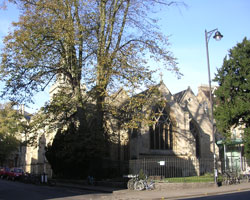 |
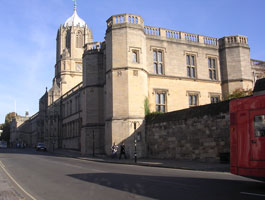 |
St Aldates Church (left) and south side of Christ Chruch College (right) between which the south gate may have been located |
|
The position of the east gate may have moved when the defences were extended. Originally it may have been near the site now occupied by the church of St Mary the Virgin. It then may have moved to the site of the later Eastgate, which was just to the east of the junction of the High Street and Merton Street. No archaeological evidence for either of these gates has been found, however the church of St Mary the Virgin is mentioned in the Domesday Book.
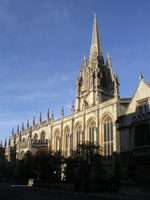 |
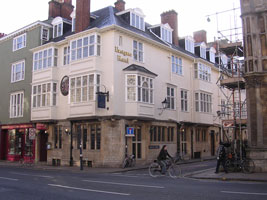 |
St Mary the Virgin Church (left) and the junction of Merton Road and the High Street (right) where east gates may have been located. |
|
The location of the west gate remains uncertain and was probably destroyed during the building of the castle. However the church of St Peter the Bailey has been suggested as a gate church and certainly existed in 1122, but is earlier history is unknown.
The Saxon Street Grid
It has been argued that the layout of Oxford was planned with a grid street plan. There is archaeological evidence for metalled street surfaces at an early date. An excavated road at New Inn Hall Street showed evidence of successive resurfacing during the later tenth or early eleventh century. It is possible an early plan was laid out when the burh was founded, but the main street layout seems to date from the mid-late tenth and early eleventh centuries.
The Founding of Oxford
It is clear that Oxford existed in the early tenth century but there is some evidence that it may have been founded during the reign of Alfred.
A type of silver penny bearing King Alfred’s name, the mint name Ohsnaforda and made by the moneyer Bernwald at Oxford has been found at several locations. It is thought the coin was minted in Oxford late in Alfred’s reign – which was from AD871-899. Hence Oxford may have been founded in the late 880s or 890s, although it was not necessarily a fortified town at this time.
Life in the Saxon Town
Excavations in the city have also revealed evidence of tenth and eleventh century life. Finds have included cess pits and buildings made of timber and wattle-and-daub. Some buildings had cellars and others small yards.
Several churches were in existence:
- St Frideswides founded by 1002
- St Ebbes founded before 1005
- St Martins founded before 1032
- St Michael at the Northgate founded by 1086 – the tower was constructed between 1010 and 1060.
- St Mary the Virgin and St Peter in the East founded by 1086
- Standing Tower of St George at the Castle built in the eleventh century.
There was rapid expansion of the town in the late Saxon period and there is evidence of occupation outside the town defences as early as the tenth century.
Archaeologists have also found evidence of crafts, industries and trades in the Saxon town, including, butchery, leatherworking, hornworking and cloth production. As we known from the coins, Oxford was also a royal mint. Finds of pottery indicate trade locally and from further afield. Thus late Saxon Oxford was a thriving town.